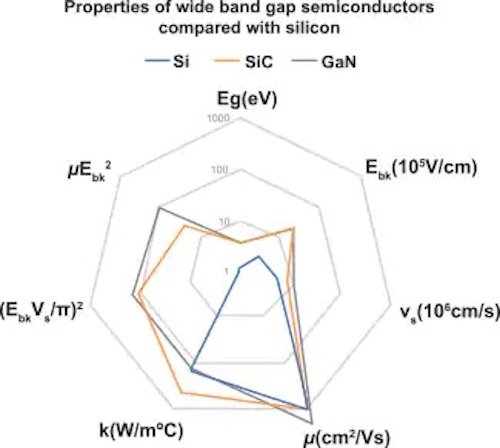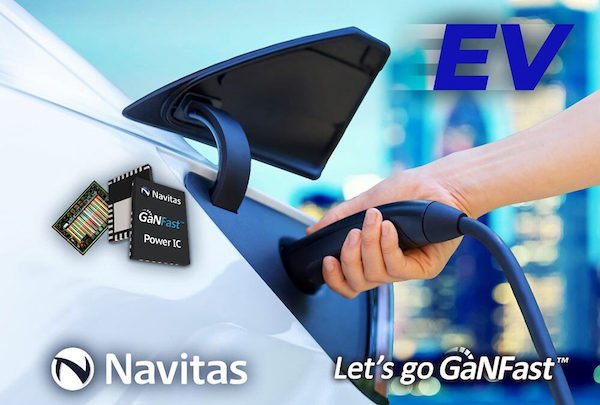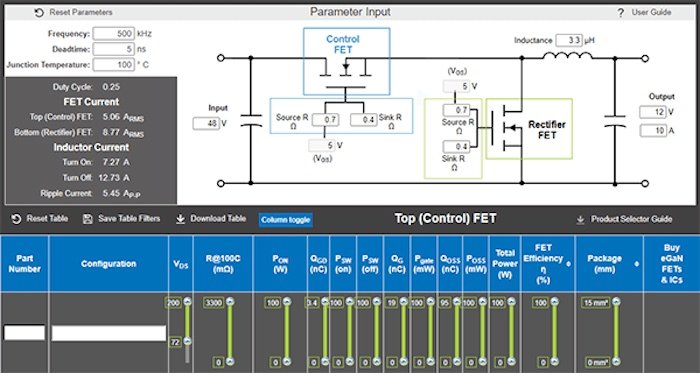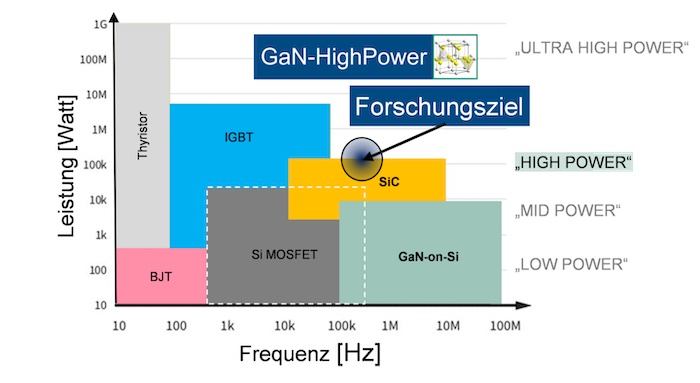GaN has been around since the 1940s, and it has taken decades to prove it can replace Si in the semiconductor world.
Through years of research and development, GaN has attempted to prove itself to be the most cost-effective, efficient, reliable, high-powered solution on the market, but it has not overthrown Si.

Comparison of wide-bandgap semiconductors. Image used courtesy of Keith Dawson and Mouser
The reason behind that is comfort. Often, it can be challenging for developers to part ways with old faithful Si and transition to something new like GaN.
On paper, GaN is a step forward, but it might not be in the eyes of product managers.
Moving forward with GaN leads many to assume that it will cost more to replace and maintain a new device in any existing system.
To remove those assumptions, GaN developers must research and show more side-by-side comparisons of how a power system, new or existing, can be impacted by GaN technology.
As 2021 ended and 2022 began, GaN developers are on track to shoot past the limit-bound Si for next-gen power ICs.
In this article, let's round up some recent innovations hoping to spur GaN designs forward.
Navitas Opens World’s First EV GaN IC Design Center
The first announcement on our list is from Navitas Semiconductor, which has been developing GaN Power ICs since 2014, aiming to integrate GaN power with dynamic control and protection for outdated power devices.
Navitas’ line of GaN ICs claims to deliver faster charging, higher power density, and greater energy savings for mobile, consumer, and energy markets.
Recently, Navitas announced a new electric vehicle (EV) design center to integrate high-power GaN ICs with onboard chargers (OBCs).

Navitas' GaNFast Power ICs claim to garner 10x lower carbon footprint than any silicon-based chip for OBCs. Image used courtesy of Navitas Semiconductor
Powered by GaN technology, Navitas claims its OBCs could yield 3x faster charge than current Si electric vehicle (EV) charging stations, along with nearly 70% of energy savings.
In addition to the OBCs, Navitas also has DC-DC converters and traction inverters estimated to extend the EV range and reduce the battery costs by adapting GaN.
Navitas’ Design Center, based in Shanghai, has a team of designers evaluating electrical, thermal, and mechanical layouts, software development, and concepts to improve EV systems through prototypes into mass production.
At the moment, the Navitas’ design team has demonstrated a high-power 650 V GaN IC for EV applications and a 6.6 kW OBC during this past CES 22’ in Las Vegas.
With this new design center, Navitas hopes to keep the design ideas flowing regarding GaN-based technology.
EPC’s Design Tools for GaN-based Power Systems
The next innovation comes from Efficient Power Conversion (EPC), which are the developers of the patented enhancement-mode GaN (eGaN).
These eGaN devices are power management FETs and ICs that go head-to-head with Si power metal-oxide-semiconductor field-effect transistors (MOSFETs) in DC-DC converters, remote sensing technology (LiDAR), and motor drives.
At the start of 2022, EPC debuted a new suite of design tools known as the GaN Power Bench.

A screenshot example of the Power Bench's GaN FET selection tool. Image used courtesy of EPC
These tools would assist engineers in finding optimal performance for any GaN-based design. The company states that design engineers can easily select from the best GaN device for any application with supporting simulations and documentation to provide what is necessary for the "ideal" system performance.
Overall, EPC's GaN Power Bench will include:
- A GaN FET selection tool for buck converters
- A FET Thermal calculator
- Cross-reference search
- Device models
- Reference designs
Engineers could benefit from EPC's enhanced product selection tool that utilizes estimation calculations for hard-switched buck converters.
With this tool, designers can input unique parameters that the selection tool will analyze. After the Power Bench reads the provided parameters, the design will receive a selection of devices that are ranked by power dissipation to compare all parameter requirements and potential design tradeoffs.
In the efforts to improve power systems in any application, EPC's GaN Power Bench will also provide a cross-reference search to find which silicon-based power management devices can swap over to eGaN FETs.
Fraunhofer IEE Investigates GaN-Based PV Inverters
Our final GaN-based innovation in this round-up is from the Fraunhofer Institute for Energy Economics and Energy System Technology (Fraunhofer IEE).
This institute is known for developing economical-based solutions to reduce energy costs and promote a wave of renewable energy transition across Europe.
Fraunhofer IEE's latest study involves producing the next-generation GaN-based photovoltaic (PV) inverters to supply sustainable and affordable energy. Fraunhofer IEE is collaborating with various PV system manufacturers to find ways to address grid stabilization on a country-wide power grid at the hardware and software level of PV inverters.

The graph shows various semiconductor components and how introducing GaN will achieve higher power density as the switching frequency increases. Image used courtesy of Fraunhofer IEE
Fraunhofer IEE researchers have begun working with SMA Solar Technology AG, a leading PV and battery inverter manufacturer, to create efficient converters for PV applications and Infineon Technologies AG, a large GaN producer in high-power applications.
These collaborations focus on pushing the limits of GaN technology as it functions in high-power applications in fast switching processes.
This project claims that it will be compared to silicon carbide (SiC), Si, and GaN technology, to provide a compelling argument for which component type can be implemented into the next-gen devices and deliver the most optimal performance.
GaN Technology Gaining Momentum
Overall, GaN developers must make a smooth transition for designers to push for the substitution of Si.
For starters, a designer can cross-reference competing for Si devices and find an optimal GaN replacement through EPC.
Next, Navitas Semiconductor is looking at EV power management. With GaN integration, there could be more trust for consumers to switch comfortably to EVs with an extended driving range and less time charging.
Finally, when harsh weather rolls into town and leaves most power grids defenseless, Fraunhofer IEE efforts could help on a global level with GaN PVs stabilizing traditional power grids.
Engineers will always have new tools, devices, and references for GaN technology as long as developers like EPC, Navitas, and Fraunhofer continue to persist for Si to be a thing of the past.
